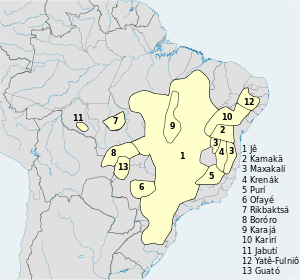Macro-Jê languages
| Macro-Jê | |
|---|---|
| Macro-Gê | |
| Geographic distribution | |
| Linguistic classification |
|
| Subdivisions | |
| Glottolog | nucl1710 (Nuclear Macro-Je)[1] |
|
The Macro-Jê families of Kaufman's conception | |
Macro-Jê (also spelled Macro-Gê) is a medium-sized language stock in South America, mostly in Brazil but also in small parts of Argentina, Paraguay and Bolivia. It is centered on the Jê language family, with all other branches currently being single languages due to recent extinctions. The family was first proposed in 1926, and has undergone moderate modifications since then. Kaufman (1990) finds the proposal "probable".
- Jê (16 languages in three branches: Kaingáng [18,000 speakers of four languages], and northern and southern Jê languages such as Xavánte [8000 speakers])
- Krenák (Botocudo)
- Borôro
- Kamakã [extinct]
- Karajá
- Karirí [extinct]
- Maxakalían
- Ofayé
- Purían [extinct]
- Rikbaktsá
- Yabutian [moribund]
Eduardo Ribeiro of the University of Chicago finds no evidence to classify Fulniô (Yatê) and Guató as Macro-Je, pace Kaufman, nor Otí and Chiquitano, pace Greenberg.[2]
These languages share irregular morphology with the Tupi and Carib families, and Rodrigues (2000) and Ribeiro connect them all as a Je–Tupi–Carib family.
Glottolog accepts Jean, Krenak (Aimore), Karaja, Maxakalian, Ofaie, Rikbaktsa, and Yabutian (Jabuti). Lexical parallels with Kamakanan and Purian have yet to be corroborated with reconstructions; the similarities with Purian disappear once Coropo is reclassified as Maxakalian. It notes suggestive grammatical similarities with Bororoan, Kariri, and Chiquitano, of the kind also shared with Tupian and Cariban, but little lexical evidence.
References
- ↑ Hammarström, Harald; Forkel, Robert; Haspelmath, Martin; Bank, Sebastian, eds. (2016). "Nuclear Macro-Je". Glottolog 2.7. Jena: Max Planck Institute for the Science of Human History.
- ↑ Ribeiro, Eduardo Rivail. 2012. A grammar of Karajá. University of Chicago. 302.
